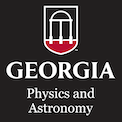Events Calendar View
-
CSP Lunch Seminar
Sep 21, 2010
Theory and Application of Environment-Sensitive Fluorescent Molecular Rotors
-
Departmental Colloquium
Sep 23, 2010
Chiral Symmetry and Medium Modification of Vector Mesons
The theory of the strong interaction, Quantum Chromodynamics (QCD), has been remarkably successful in describing high-energy and short-distance-scale experiments involving quarks and gluons. However, applying QCD to low energy and large-distance-scale experiments has been a major challenge. Chiral symmetry is one of the most fundamental symmetries in QCD and provides guiding principles to deal with strong interaction phenomena in the non-perturbative domain. Most of the mass of ordinary matter (98%) is generated by the spontaneous breaking of Chiral symmetry in the vacuum. Various QCD-inspired models predict a modification of the properties of hadrons in nuclear matter from their free-space values. A review of experiments searching for the in-medium modifications of light mesons will be given trying to assess if they confirm or refute these theoretical predictions. Several complementary high statistics experiments are planned at different nuclear physics accelerators (JLab, GSI, JPARC and RHIC) to further study the properties of hadrons in the medium.
-
NanoSEC Seminar
Sep 24, 2010
Molecules and Materials for 21st Century Needs
With our perspective at the beginning of a new decade, it seems clear that the 21st century will be an age when custom-tailored molecules and materials will reach an unprecedented level of importance. In this talk, I will describe several examples of custom-tailored molecules and materials that range across the fields of organometallic chemistry and materials science and have applications in catalysis, chemical synthesis, and energy production.
-
CSP Lunch Seminar
Sep 28, 2010
Study of Vapor Deposition Polymerization Growth Model
-
Departmental Colloquium
Sep 30, 2010
From Magnetic Resonance to Molecular Imaging of Biological Systems and Diseases with MRI
The state of the art MRI has become a powerful and primary tool for non-invasive imaging of living systems both in laboratory research and clinical practices. The guidance and applications of physics principles have played critical roles in many aspects of magnetic resonance imaging (MRI), from the discovery of magnetic resonance phenomenon to the development of a library of imaging methods and technology. As MRI becomes a junction of sciences, engineering, biomedical discoveries and clinical applications, we should reflect the impact of physics and look forward to its continuous influences to the development and direction of magnetic resonance imaging field and beyond. With this in mind, I will share with you my laboratory’s current research and experiences in developing MRI methods and applications for diagnostic imaging and medical research. The implementation and applications of diffusion and diffusion tensor imaging to study brain diseases, such as Alzheimer’s disease, will be discussed in the presentation. In addition, I will introduce our work in developing novel magnetic nanoparticles as MR molecular imaging probes for biomarker targeted imaging of cancers as well as some new MRI methods for molecular imaging. Looking into the future, we anticipate that MRI will continue to provide great opportunities for physics to make ground-breaking contributions to biomedical research and discoveries.
-
NanoSEC Seminar
Oct 1, 2010
Nanostructure Multiband Detectors for UV to Far Infrared
Semiconductor quantum dots are nano-particles showing remarkable optical properties from ultraviolet (UV) to infrared (IR) regions. Most of the quantum dots operating in visible or near-infrared regions utilize the electronic transitions between the valence and conduction sub-bands across the fundamental band-gap of the semiconductor material. In the infrared region, quantum dots are operated utilizing the electronic transitions between the sub-bands within the conduction (or valence) band. Here, various quantum dot infrared photodetector (QDIP) structures are presented. These can be operated as multi-band detectors in the mid-long-and far-infrared regions (terahertz). Specific QDIP architectures include dots-in-a-well (DWELL), tunneling quantum dot (T-QDIP), and superlattice quantum dot (SL-QDIP) structures. DWELL exhibits multi-color characteristics and offers wavelength tunability based on well parameters, instead of the quantum dot size. The main idea of T-QDIP is to reduce the dark current without reducing the photocurrent but can also be used for bias-selectable multi-band detectors, as well as for terahertz detectors. Similar to quantum dots, quantum ring photodetector structures (QRIPs) will also be presented, which were specifically designed for terahertz detection. As a second approach to achieve bias-selectable response peaks, a quantum well photodetector (QWIP) structure, known as npn-QWIP which also assembles two back-to-back connected p-i-n diodes with the p-region being common is discussed. A theoretical work supported by some preliminary experiments on the polarization sensitivity of QWIP coupled to 1D metal grids will also be discussed presented. The polarization extinction ratio is based on the polarization sensitivity of the diffraction grid, which depends on grid parameters, as well as the intrinsic polarization sensitivity of the photodetector itself. A low-cost photoconductive dual-band detector based on a ZnO film sensitized with lead sulfide quantum dots (PbS-QDs) is also presented. The UV response arises from the interband absorption of UV radiation by ZnO, and the IR response is due to the absorption in the PbS-QDs. Finally, as time permits, homojunction/heterojunction detector structures will be discussed with an emphasis on spin split-off detectors, which are operated based on light/heavy hole to split-off band transitions in p-type doped emitter layers at the interface of a heterojunction structure.
Page 12 of 121, showing 6 records out of 723 total, starting on record 67, ending on 72


